
A Century of Reading: The 10 Books That Defined the 1990s
It's What You Want, What You Really Really Want
Some books are flashes in the pan, read for entertainment and then left on a bus seat for the next lucky person to pick up and enjoy, forgotten by most after their season has passed. Others stick around, are read and re-read, are taught and discussed. sometimes due to great artistry, sometimes due to luck, and sometimes because they manage to recognize and capture some element of the culture of the time.
In the moment, you often can’t tell which books are which. The Great Gatsby wasn’t a bestseller upon its release, but we now see it as emblematic of a certain American sensibility in the 1920s. Of course, hindsight can also distort the senses; the canon looms and obscures. Still, over the next weeks, we’ll be publishing a list a day, each one attempting to define a discrete decade, starting with the 1900s (as you’ve no doubt guessed by now) and counting down until we get to the (nearly complete) 2010s.
Though the books on these lists need not be American in origin, I am looking for books that evoke some aspect of American life, actual or intellectual, in each decade—a global lens would require a much longer list. And of course, varied and complex as it is, there’s no list that could truly define American life over ten or any number of years, so I do not make any claim on exhaustiveness. I’ve simply selected books that, if read together, would give a fair picture of the landscape of literary culture for that decade—both as it was and as it is remembered. Finally, two process notes: I’ve limited myself to one book for author over the entire 12-part list, so you may see certain works skipped over in favor of others, even if both are important (for instance, I ignored Dubliners in the 1910s so I could include Ulysses in the 1920s), and in the case of translated work, I’ll be using the date of the English translation, for obvious reasons.
For our tenth installment, below you’ll find 10 books that defined the 1990s. (Head here for the 1910s, 20s, 30s, 40s, 50s, 60s, 70s, and 80s).
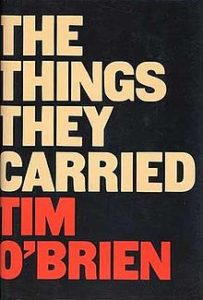 Tim O’Brien, The Things They Carried (1990)
Tim O’Brien, The Things They Carried (1990)
The Things They Carried was O’Brien’s third book about Vietnam, but it’s frequently heralded as one of the best books ever written about the war. It sold “well over two million copies worldwide” and was a finalist for the Pulitzer Prize as well as the National Book Critics Circle Award. “The Things They Carried has lived in the bellies of American readers for more than two decades,” A. O. Scott wrote in 2013. “It sits on the narrow shelf of indispensable works by witnesses to and participants in the fighting, alongside Michael Herr’s Dispatches, Tobias Wolff’s In Pharaoh’s Army, and James Webb’s Fields of Fire.” As far as its enduring legacy, Scott goes on:
In 1990, when Houghton Mifflin published the book, Vietnam was still recent history, its individual and collective wounds far from healed. Just as the years between combat and publication affected O’Brien’s perception of events, so has an almost exactly equal span changed the character of the writing. The Things They Carried is now, like the war it depicts, an object of classroom study, kept relevant more by its craft than by the urgency of its subject matter. The raw, restless, anguished reckoning inscribed in its pages—the “gut hate” and comradely love that motivated the soldiers—has come to reflect conventional historical wisdom. Over time, America’s wars are written in shorthand: World War II is noble sacrifice; the Civil War, tragic fratricide; Vietnam, black humor and moral ambiguity.
I’d argue that The Things They Carried is now itself a one-volume shorthand for the Vietnam War—or the closest thing to it.
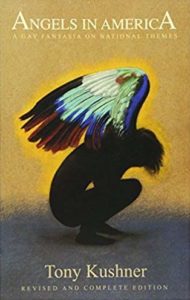 Tony Kushner, Angels in America (1991)
Tony Kushner, Angels in America (1991)
Look, a play! Kushner’s Angels in America: A Gay Fantasia on National Themes was a huge hit and subject of national discussion when it was first performed, and won the Pulitzer Prize for Drama, two Tony Awards for Best Play, and the Drama Desk Award for Outstanding Play. In 2005, John Lahr called it “the first major play to put homosexual life at the center of its moral debate, [covering] territory that ranged from Heaven to earth, from the AIDS epidemic to conservative politics, encapsulating, in its visionary sweep, the sense of confusion and longing that defined late-twentieth-century American life.
“It gave a language to that generation,” the director George C. Wolfe, who staged both Angels in America and Caroline, or Change on Broadway, says. “It gave playwrights permission to think about theatre in a whole new way. A play could be poetic, ridiculous, fragile, overtly political, sentimental, and brave all at the same time. . . . [Angels in America] was an epic discourse on American life that mixed social reality with theatrical fantasy, naturalism with Judaism and magical realism. It told its story in numerous dialects—camp, black, Jewish, Wasp, even Biblical tones. At the same time, it provided a detailed map of the nation’s sense of loss.
. . .
Twenty-four characters, eight acts, fifty-nine scenes, and an epilogue: Angels in America turned the struggle of a minority into a metaphor for America’s search for self-definition. “I hate this country,” a gay black nurse called Belize says to Louis. “It’s just big ideas, and stories, and people dying, and people like you. The white cracker who wrote the national anthem knew what he was doing. He set the word ‘free’ to a note so high nobody can reach it.” Although “Angels” was not the first play to explore the aids pandemic—Larry Kramer’s polemical “The Normal Heart” (1985) preceded it—it was the first to explore the particular claim of the disenfranchised to a romantic vision of America. “We will be citizens,” Prior announces to the audience at the finale. “The time has come.”
It was a huge success, “hailed as a turning point for theatre, for gay life, and for American culture,” and its legacy was only further secured by the HBO miniseries, which, in 2004, won a then-record-breaking 11 Emmys.
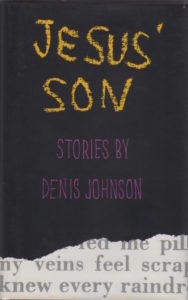 Denis Johnson, Jesus’ Son (1992)
Denis Johnson, Jesus’ Son (1992)
I don’t know about its national importance, necessarily, but this here is a literary website, and few books have had as direct and intense an impact on the literary world as Johnson’s cult story collection. I mean, it’s safe to say that almost every writer has read it, and about half of them have tried to emulate it (“So many people want to write this book over again,” Michael Cunningham once said). When I was accepted into an MFA program, another writer friend gave me a copy and inscribed it: “So you’ll know what everyone is talking about.” I read it, and found out, but personally prefer Train Dreams. However, I am rather in the minority. But the book is more than just a cult novel, as William Giraldi has attested in Poets & Writers.
It’s beautiful to see, back pockets sprouting Jesus’ Son, but I’ve wondered: Do all those hip young men believe “I knew every raindrop by its name” can mean anything they want it to mean? Are these back pockets evidence of what is lazily referred to as the book’s “cult following”? Consider that in the novel More Die of Heartbreak (William Morrow, 1987), Saul Bellow has that wonderful line to the effect that cults are neither that hard to get nor that much to be proud of. If ever you hear that a writer has a cult following, pause to remind yourself what a cult actually is and how cults usually end. Jesus’ Son, the preeminent story collection of the American 1990s, is worthy of much more than mere cultism.
. . .
The collection is singular in its alloy of rarities. It wields a visionary language that mingles the Byronic with the demotic—a language of the dispossessed, half spare in bewilderment, half ecstatic in hope. There’s the bantam power of its brevity—you can read the book in one sitting—and the pitiless, poetic excavation of an underground existence bombed by narcotics, of psyches that prefer the time of their lives to the lives of their time. It boasts a deft circumvention of that tired trope polluting so many American stories of addiction: the trek from cursed to cured, from lost to loved, from breakdown to breakthrough. It also maintains an effortless appropriation of elements from the three most important story writers of the American twentieth century: Ernest Hemingway’s sanctifying of the natural world in The Nick Adams Stories; Flannery O’Connor’s spiritual grotesquerie and redemptive questing; and Raymond Carver’s noble ciphers manhandled by the falsity of the American Dream (Johnson was one of Carver’s drinking compeers at Iowa in the early 1970s).
“We go to Jesus’ Son precisely because in its most sublime moments it reveals to us a condition both lesser and greater than human,” Giraldi concludes. “We go to it for the flawlessness of its aesthetic form, its transformative spiritual seeing, and the beauty, the deathless beauty, of sentences that sing of possible bliss.”
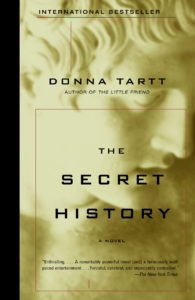 Donna Tartt, The Secret History (1992)
Donna Tartt, The Secret History (1992)
“How best to describe Donna Tartt’s enthralling first novel?” wondered Michiko Kakutani in a 1992 review. “Imagine the plot of Dostoyevsky’s Crime and Punishment crossed with the story of Euripides’ Bacchae set against the backdrop of Bret Easton Ellis’s Rules of Attraction and told in the elegant, ruminative voice of Evelyn Waugh’s Brideshead Revisited. The product, surprisingly enough, isn’t a derivative jumble, but a remarkably powerful novel that seems sure to win a lengthy stay on the best-seller lists.” Well, she wasn’t wrong—everyone’s favorite novel from the 90s was a full blown phenomenon, hyped to infinity but with good reason, both critically and commercially successful—and though not every critic was on board, the Cult of Donna was born.
Plus, as Ted Gioia put it, “The Secret History is, by any measure, a significant fiction, and arguably the book that tilted the scales away from the minimalist 1980s fictions with their Raymond Carveresque starkness, and toward the more maximalist sensibility that has been in the ascendancy in recent years.”
 Jeffrey Eugenides, The Virgin Suicides (1993)
Jeffrey Eugenides, The Virgin Suicides (1993)
The Literary Hub office was split over whether to include The Virgin Suicides here or wait for the next decade to champion Middlesex, but in the end, we couldn’t think of the 90s without Eugenides’ debut. It is a rare book that feels absolutely essential to and evocative of the decade—but also not at all bound by it. As Emma Cline wrote in a new introduction to the novel,
Even as Eugenides interrogates the postwar suburban dream, the “dying empire” of a Michigan town, there’s a sense of timelessness, the setting both immediate and otherworldly, toggling between the daily boredoms of teen-agers and a realm almost mythic: when Cecilia slits her wrists, the paramedics with the stretcher are described as “slaves offering the victim to the altar,” Cecilia as “the drugged virgin rising up on her elbows, with an otherworldly smile on her pale lips.”
Twenty-five years later, I’d argue it holds up. The fact that it spawned an equally-iconic film is only icing on the cake.
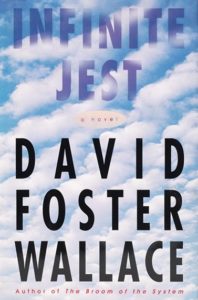 David Foster Wallace, Infinite Jest (1996)
David Foster Wallace, Infinite Jest (1996)
Yes, well. Despite the fact that lots of annoying dudes love this book, and Wallace’s own unignorable abusive tendencies, it’s more or less the ur-text of the literary 90s. The 1,000+ page tome was a bestseller (if not on the level as some of the others on this list) and a landmark literary event. The book, wrote one reviewer upon its publication, “has been moving toward us like an ocean disturbance, pushing increasingly hyperbolic rumors before it: that the author could not stop writing; that the publisher was begging for cuts of hundreds of pages; that it was, qua novel, a very strange piece of business altogether. Now it’s here and, yes, it is strange, not just in its radically cantilevered plot conception but also in its size (more than a thousand pages, one tenth of that bulk taking the form of endnotes): this, mind you, in an era when publishers express very real doubts about whether the younger generation—presumably a good part of Wallace’s target audience—reads at all.” People read—or at least people bought—and the book became a touchstone of literary culture, one that we’ve been arguing over and dissecting and refusing to read and forcing others to read and needing help to read ever since.
“Read today, the book’s intellectually slapstick vision of corporatism run amok embeds it within the early to mid-1990s as firmly and emblematically as “The Simpsons” and grunge music,” wrote Tom Bissell on the book’s 20th anniversary.
It is very much a novel of its time. How is it, then, that Infinite Jest still feels so transcendentally, electrically alive? Theory 1: As a novel about an “entertainment” weaponized to enslave and destroy all who look upon it, Infinite Jest is the first great Internet novel. . . . That 20 years have gone by and we still do not agree what this novel means, or what exactly it was trying to say, despite saying (seemingly) everything about everything, is yet another perfect analogy for the Internet. Both are too big. Both contain too much. Both welcome you in. Both push you away.
Bissell has some other theories, but most important to our purposes is his final one: that “Infinite Jest is unquestionably the novel of its generation.”
 Helen Fielding, Bridget Jones’ Diary (1996)
Helen Fielding, Bridget Jones’ Diary (1996)
I don’t know what to tell you. This book is good, and truly funny—and it’s also widely credited with kicking off an enormous wave of “chick-lit” (and attendant money for authors and publishers) on both sides of the pond. It not only reflected the culture of the 90s but also invented some of it—or at least a lot of its terminology. Were Americans saying “fuckwit” before Bridget? I think not. In closing, here is a blurb from Salman Rushdie: “Even men will laugh.” Even men, indeed.
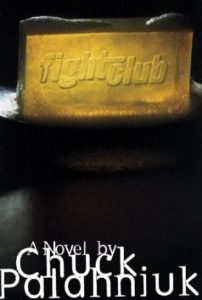 Chuck Palahniuk, Fight Club (1996)
Chuck Palahniuk, Fight Club (1996)
Typically, when it comes to Fight Club (and Palahniuk in general) I like to abide by the first rule of fight club. But alas, it’s the 90s, and there’s no ignoring it. The book was well-reviewed but sold modestly when it was first published—around 5,000 copies—but when the film came out in 1999, it became a cult phenomenon, particularly among young white men, and sales of the book skyrocketed.
But in retrospect, legacy hasn’t been great. These days, Fight Club is an inspirational text to incels, who look to it “as an example of why one shouldn’t underestimate ordinary frustrated men.” The term “snowflake” (in its current usage as an insult used by right wing boors, at least) comes from the novel, and Palahniuk is proud to have coined it. “There is a kind of new Victorianism,” he told the Evening Standard in 2017. “The modern Left is always reacting to things. Once they get their show on the road culturally they will stop being so offended.”
You can argue whether the novel glorifies or attempts to criticize toxic masculinity (I find the latter reading more palatable but extremely generous, considering the above), but there’s no doubt that toxic masculinity is its subject—a subject very relevant to the 90s, and also the present. As Ted Gioia wrote,
A real subculture exists that matches, to some degree, the rule-breaking ethos depicted in Fight Club. I’m not surprised that, in the years following the publication of this novel, the author was frequently approached by fans who either (1) believed that many elements in it were based on actual events, or (2) were determined to turn them into actual events. From this perspective, Palahniuk has at least surpassed Bret Easton Ellis, whose Harvard-MBA-turned-serial-killer is pure hokum aimed to gain notoriety through sheer shock value.
Which reminds me: American Psycho was published in the 90s too—but Fight Club has beaten it to the top 10 because of the 80s-ness of the former, and because of exactly what Gioia suggests above.
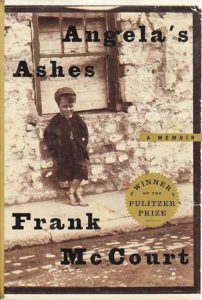 Frank McCourt, Angela’s Ashes (1996)
Frank McCourt, Angela’s Ashes (1996)
Listen, as far as 90s memoirs go, I personally wanted to champion a) Mary Karr’s The Liars’ Club (1995) or b) Elizabeth Wurtzel’s Prozac Nation (1994), but the Literary Hub office at large shouted me down. Apparently Angela’s Ashes is kind of a big deal. Sure, it sold some 4 million copies, even before the movie came out, was on the bestseller list for 117 weeks, won a Pulitzer Prize and a NBCC award, and was translated into over 20 languages, and is more or less the reigning champion of the Misery Memoir. America loved it, but folks from Limerick weren’t as pleased, accusing McCourt of exaggeration. One of them ripped up a copy in front of the writer at a book signing. “He named names. He insulted people,” said the book-defacer. “Most of the people are dead. But the families have to suffer and live with the consequences.” Apparently, even Angela herself (read: McCourt’s mother) once stood up at one of the author’s appearances to yell out, “It didn’t happen that way! It’s all a pack of lies!” Ouch.
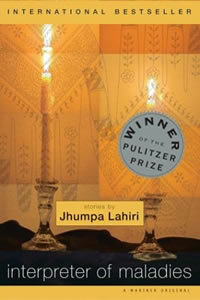 Jhumpa Lahiri, The Interpreter of Maladies (1999)
Jhumpa Lahiri, The Interpreter of Maladies (1999)
To be fair, this book was barely published in the 90s—I’m sure more people read it in the early 2000s—but it was a sensation, and I can’t possibly discount it. Everyone read this book. It was a huge bestseller, selling upwards of 15 million copies, which is astounding for a short story collection, and won both the Pulitzer (making Lahiri the first person of South Asian descent to win an individual Pulitzer Prize) and the PEN Award. In World Literature Today, Ronny Noor wrote that “The value of these stories—although some of them are loosely constructed—lies in the fact that they transcend confined borders of immigrant experience to embrace larger age-old issues that are, in the words of Ralph Waldo Emerson, ‘cast into the mould of these new times’ redefining America.”
See also (these lists are getting longer with each decade as the culling clarity of hindsight grows hazier):
Walter Mosley, Devil in a Blue Dress (1990), Hanif Kureishi, The Buddha of Suburbia (1990), Naomi Wolf, The Beauty Myth (1990), Charles Johnson, Middle Passage (1990), A. S. Byatt, Possession (1990), Elmore Leonard, Get Shorty (1990), Michael Crichton, Jurassic Park (1990), James Ellroy, L.A. Confidential (1990), Janet Malcolm, The Journalist and the Murderer (1990), Judith Butler, Gender Trouble (1990), Douglas Coupland, Generation X (1991), Jane Smiley, A Thousand Acres (1991), Diana Gabaldon, Outlander (1991), Julia Alvarez, How the Garcia Girls Lost Their Accents (1991), Ben Okri, The Famished Road (1991), Art Spiegelman, Maus II (1991), Norman Rush, Mating (1991), David Gates, Jernigan (1991), Martin Amis, Time’s Arrow (1991), Bret Easton Ellis, American Psycho (1991), Alex Kotlowitz, There Are No Children Here (1991), John Grisham, The Firm (1991), Jung Chang, Wild Swans (1992), Madonna, Sex (1992), Cormac McCarthy, All the Pretty Horses (1992), Michael Ondaatje, The English Patient (1992), Joyce Carol Oates, Black Water (1992), Toni Morrison, Jazz (1992), Robert James Waller, The Bridges of Madison County (1992), Paulo Coelho, The Alchemist (first English translation, 1993), Annie Proulx, The Shipping News (1993), Lois Lowry, The Giver (1993), Ernest J. Gaines, A Lesson Before Dying (1993), Roddy Doyle, Paddy Clarke Ha Ha Ha (1993), Scott McCloud, Understanding Comics (1993), Irvine Welsh, Trainspotting (1993), Carol Shields, The Stone Diaries (1993), Elizabeth Wurtzel, Prozac Nation (1994), John Berendt, Midnight in the Garden of Good and Evil (1994), Rick Moody, The Ice Storm (1994), Laura Esquivel, Like Water for Chocolate (first English translation, 1995), Kenzaburo Oe, Nip the Buds, Shoot the Kids (first English translation, 1995), Nick Hornby, High Fidelity (1995), Philip Pullman, The Golden Compass (1995), Mary Karr, The Liars’ Club (1995), Philip Roth, Sabbath’s Theater (1995), Richard Ford, Independence Day (1995), Nelson Mandela, Long Walk to Freedom (1995), Barack Obama, Dreams from My Father (1995), Javier Marías, A Heart So White (first English translation, 1995), Margaret Edson, Wit (1995), Margaret Atwood, Alias Grace (1996), Jon Krakauer, Into the Wild (1996), Candace Bushnell, Sex and the City (1996), Junot Díaz, Drown (1996), Alex Garland, The Beach (1996), Stephen King, The Green Mile (1996), George Saunders, CivilWarLand in Bad Decline (1996), Mitch Albom, Tuesdays With Morrie (1997), J. K. Rowling, Harry Potter and the Sorcerer’s Stone (1997), Haruki Murakami, The Wind-Up Bird Chronicle (first English translation, 1997), Charles Frazier, Cold Mountain (1997), Bill Bryson, A Walk in the Woods (1997), George R. R. Martin, A Game of Thrones (1997), Philip Roth, American Pastoral (1997), Jared Diamond, Guns, Germs, and Steel (1997), Daniel Clowes, Ghost World (1997), Geoff Dyer, Out of Sheer Rage (1997), Don DeLillo, Underworld (1997), Sebastian Junger, The Perfect Storm (1997), José Saramago, Blindness (first English translation, 1997), Chris Kraus, I Love Dick (1997), Thomas Pynchon, Mason & Dixon (1997), Arundhati Roy, The God of Small Things (1997), Eve Ensler, The Vagina Monologues (1998), Barbara Kingsolver, The Poisonwood Bible (1998), Edwidge Danticat, Breath, Eyes, Memory (1998), Anne Carson, Autobiography of Red (1998), Michael Cunningham, The Hours (1998), Nick Hornby, About a Boy (1998), Lorrie Moore, Birds of America (1998), Tom Perrotta, Election (1998), Louis Sachar, Holes (1998), Alexander McCall Smith, The No. 1 Ladies’ Detective Agency (1998), W. G. Sebald, The Rings of Saturn (first English translation, 1998), Tom Wolfe, A Man in Full (1998), Stephen Chbosky, The Perks of Being a Wallflower (1999), Jonathan Lethem, Motherless Brooklyn (1999), Annie Proulx, Close Range: Wyoming Stories (1999), Ha Jin, Waiting (1999), J. M. Coetzee, Disgrace (1999), Colson Whitehead, The Intuitionist (1999)
Emily Temple
Emily Temple is the managing editor at Lit Hub. Her first novel, The Lightness, was published by William Morrow/HarperCollins in June 2020. You can buy it here.



















